Set to be unveiled later this week, Apple’s iPhone 7 has unfairly been categorized as a middle-of-the-road upgrade. Sure, the iPhone 7 may not introduce a radical new design or form factor, but there are still no shortage of reasons to get excited about Apple’s next-gen smartphone. In particular, the dual camera system that will grace Apple’s 5.5-inch iPhone 7 will likely represent a monumental leap forward in smartphone camera quality.
Based on any number of credible reports, the dual camera system on the iPhone 7 Plus will largely be based on technology Apple picked up when it acquired a company called LinX back in early 2015. Originally based out of Israel, LinX’s advanced camera technology was capable of delivering superior camera performance across a number of different shooting environments, including low light situations. What’s more, LinX’s technology was said to capture “gorgeous photos in the most challenging environments (flares, mist, reflections, very close objects, etc).” Further, LinX’s slim camera models also served up marked improvements in color accuracy, noise levels, shutter lag, color uniformity and much more.
DON’T MISS: All the reasons Apple’s ‘boring’ new iPhone 7 will be its most exciting iPhone ever
Before LinX’s website was taken down, the company boasted that its cameras were ““leading the way to DSLR performance in slim handsets.” To this point, it’s also worth noting that well-connected Apple blogger John Gruber has also heard rumblings about Apple’s next-gen iPhone perhaps entering DSLR photo quality territory.
During a November episode of his The Talk Show podcast, Gruber said that Apple’s next-gen iPhone could very well represent the biggest jump in iPhone camera quality yet.
“I don’t even know what sense this makes,” Gruber said, “but I’ve heard that it’s some kind of weird two-lens system where the back camera uses two lenses and it somehow takes it up into DSLR quality imagery.”
In addition to providing incredible image quality, LinX’s dual camera implementation will also provide enhanced detail when zooming in.
As evidenced below, the image on the left illustrates what a zoomed in image looks like with just one camera lens. The crisper image on the right, meanwhile, is the result of a dual camera implementation. Note that the image below is based on dual camera technology from another company called Corephotonics. Nonetheless, it provides us with a good representation of what the iPhone 7 Plus will likely deliver.

As to some other features that LinX’s camera sensors were capable of, a company presentation from late 2014 detailed a number of reasons why its technology was far superior to traditional smartphone cameras at the time, including:
- A larger sensor requires a longer lens. Therefore, by replacing one large sensor with two or more smaller ones, we reduced the height of our device by a factor of 1.4 to 2
- Sensitivity to light increases by a factor of 3 by using a monochrome sensor
- Noise levels are dramatically lower
- The effective array camera resolution is similar to the single aperture camera in high light
- Performance and image quality in low light are extraordinary
- Allowing a fast exposure at indoor standard lighting conditions of 100-200 lux which assures crisp images free from motion blur
- The multi-aperture camera creates a real-time, high-quality distance map
- Multi-aperture LinX products open the door for real-time applications that use images and distance maps together, such as:
- Automatic background removal
- Refocusing
- High-quality control of autofocus in video mode when one of the cameras is equipped with autofocus (range finder camera)
- Augmented reality
- 3D object modeling
- Distance and Sizing of objects
- Biometric 3D face recognition
While not all of these features will make it into the iPhone 7 Plus, it does suggest that we can expect Apple to announce some major smartphone camera innovations later this week. And while the iPhone 7 Plus may be the only device graced with a dual camera system for now, it stands to reason that the technology will inevitably make its way down to the 4.7-inch iPhone model, perhaps as soon as 2017.
It’s also worth noting that LinX also boasted that its camera technology was capable of accurately gauging depth, and in turn, creating depth maps like the ones below.


As to any practical applications of being able to measure depth, LinX a few years back listed out a few examples.
- 3D scanning of objects
- Sizing of objects
- Refocusing: knowing the depth at every pixels allows us to apply a synthetic blur to emulate a shallow depth of Field
- Background removal and replacement
- Gesture recognition
Lastly, the following video highlights some of LinX’s exciting camera technology that we’ll likely see Tim Cook and co. introduce later this week.








